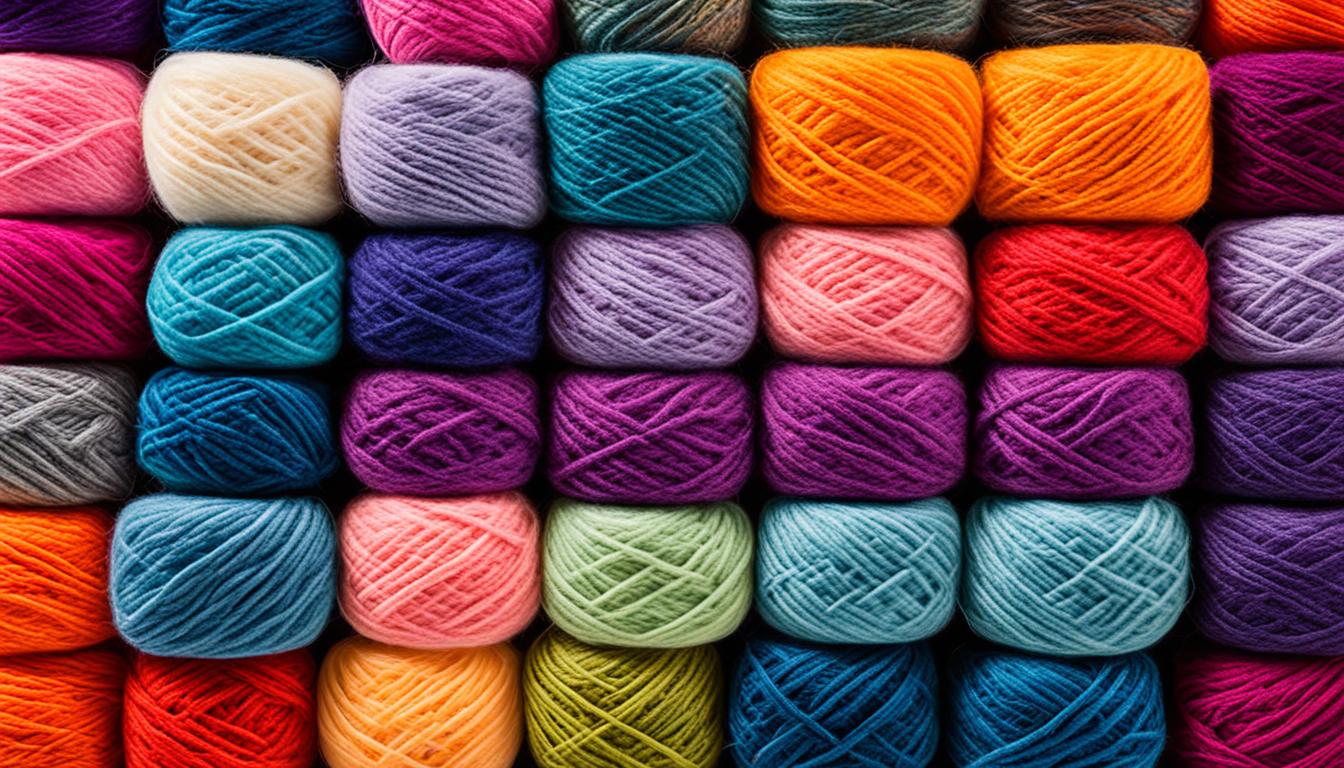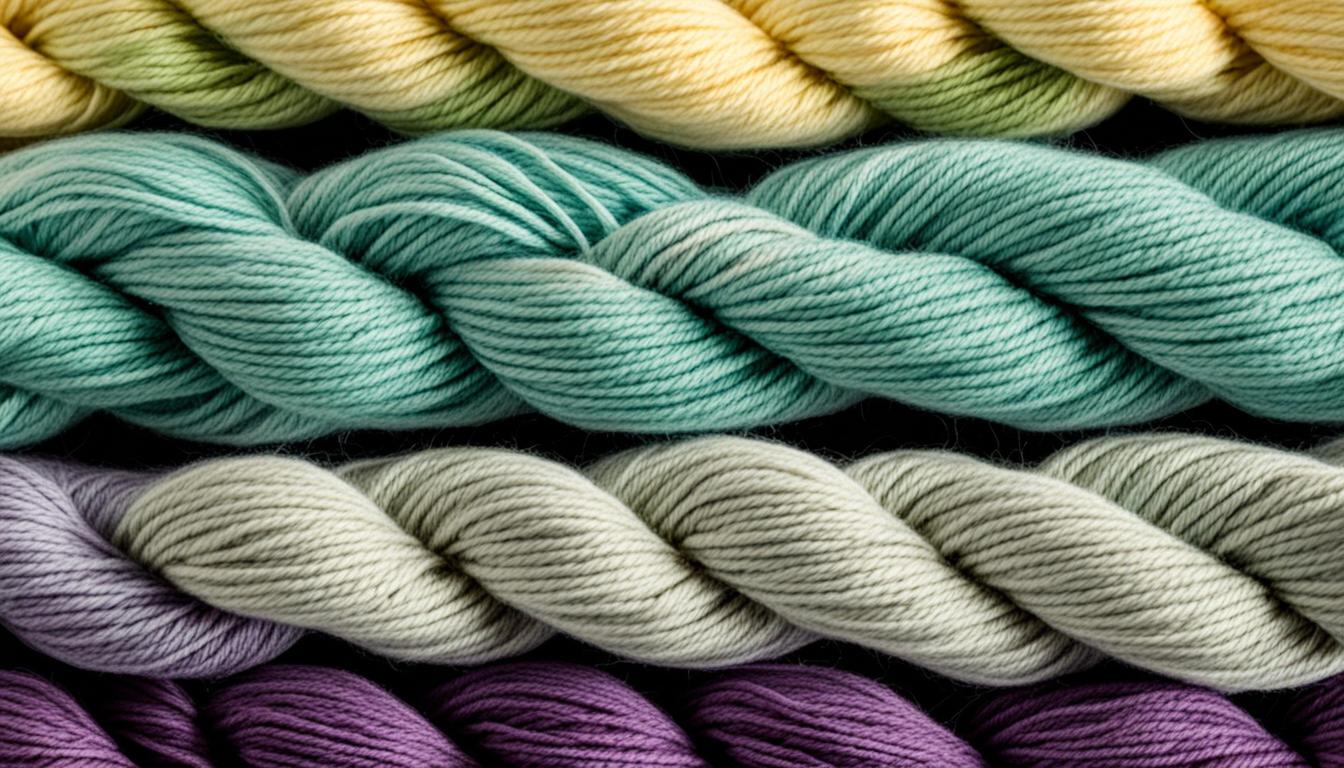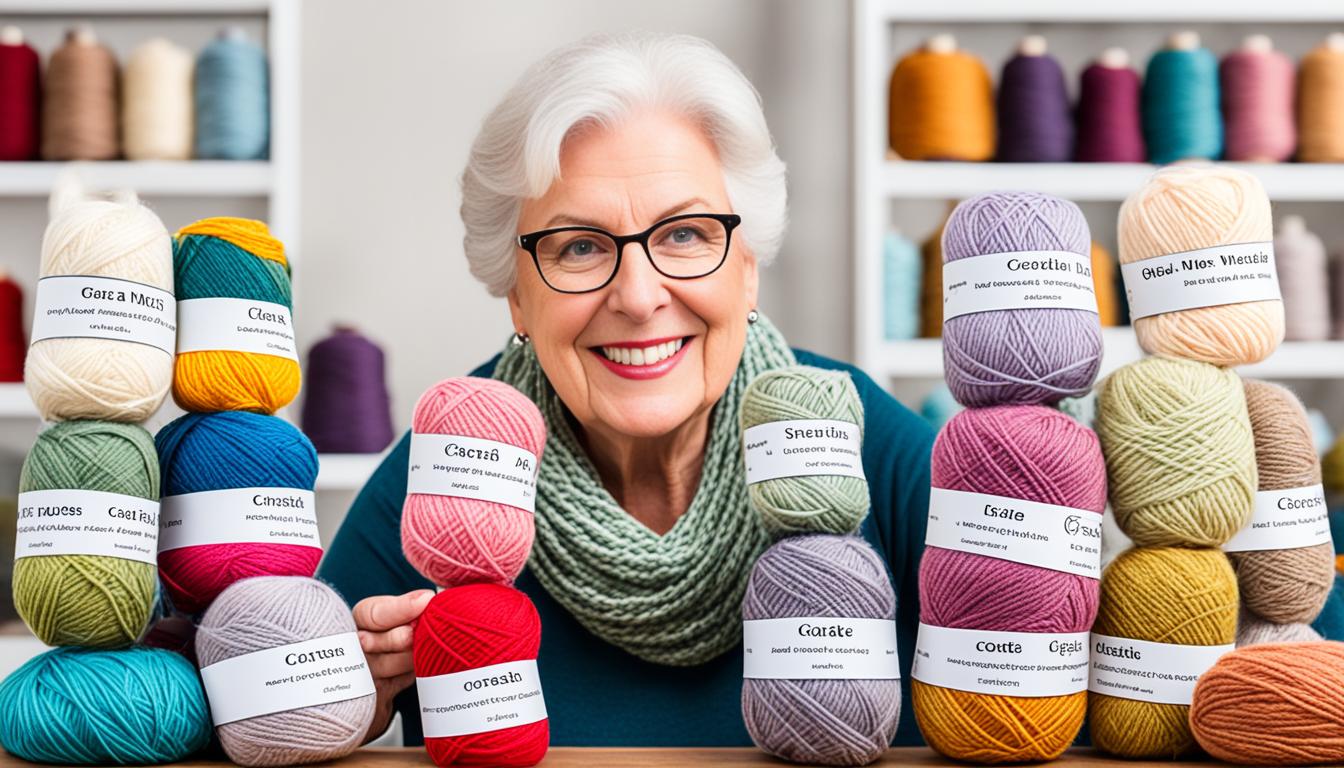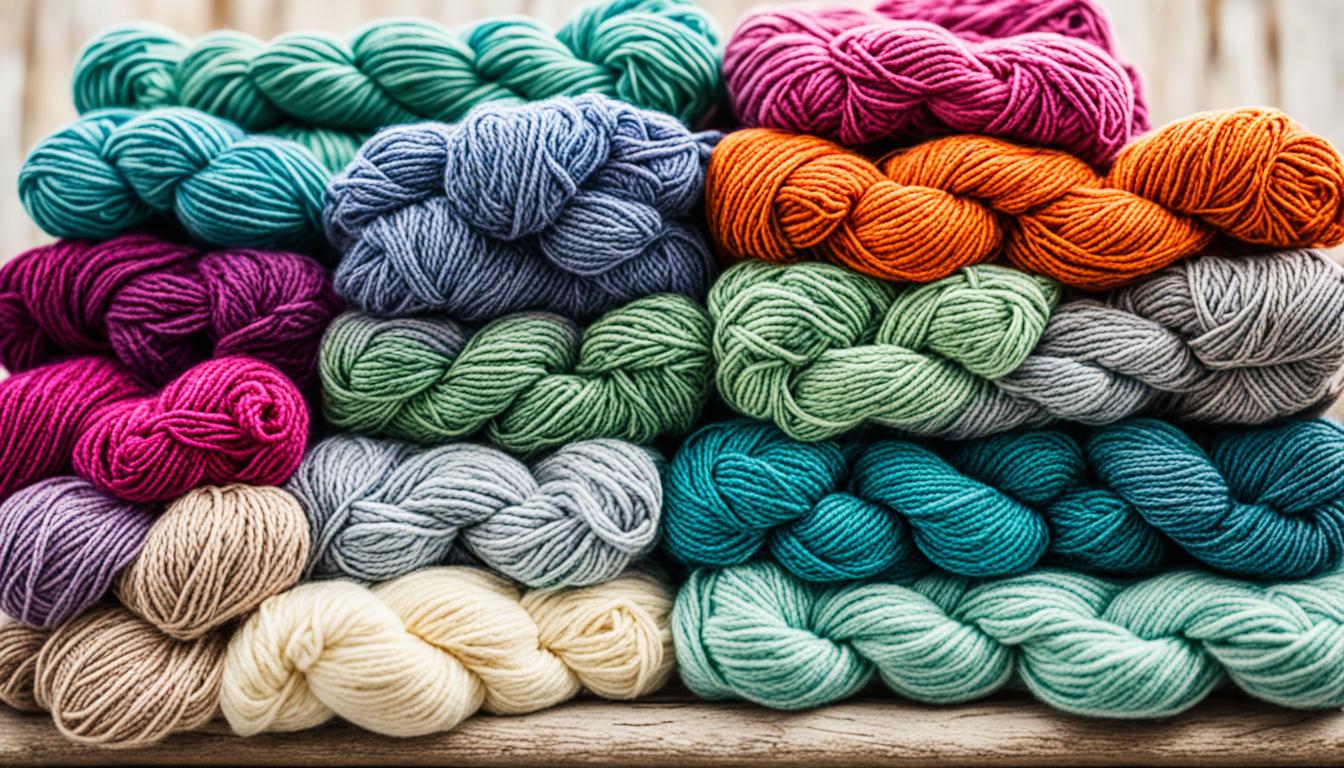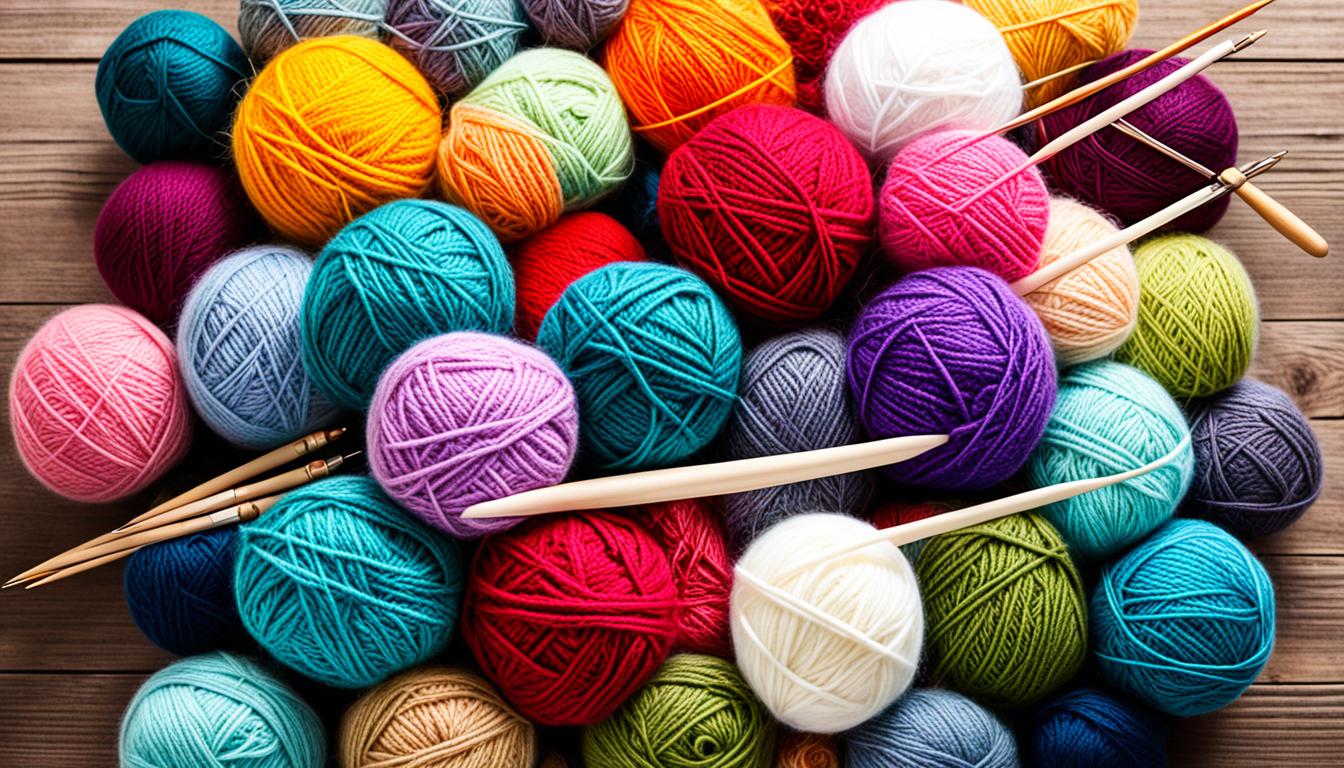What type of yarn is best for tufting? The increasing trend of tufting has sparked curiosity among craft enthusiasts. The choice of yarn plays a crucial role in determining the texture, strength, and overall look of your tufted creations. Let’s explore the various types of yarn for tufting to help you find the ideal fit.
Key Takeaways:
- Choosing the right yarn is crucial for achieving the desired texture, durability, and appearance in tufting projects.
- Wool yarn offers natural durability, softness, and stain resistance, making it a popular choice.
- Acrylic yarn is affordable, durable, and colorfast, providing a wide range of options for tufting.
- Nylon yarn is known for its strength, durability, and resistance to abrasion, making it ideal for high-traffic areas.
- Polyester yarn is affordable, stain-resistant, and available in various colors and textures for versatile tufting projects.
Wool Yarn
When it comes to tufting, wool yarn is a top choice for many craft enthusiasts. This popular yarn offers a range of benefits that make it the best yarn for tufting projects.
One of the standout properties of wool yarn is its natural durability. The strong fibers of wool provide long-lasting wear, ensuring that your tufted creations can withstand daily use.
In addition to durability, wool yarn also offers a luxurious softness that adds a plush feel to your tufted pieces. Whether you’re creating a cozy rug or a decorative cushion, wool yarn will provide a comfortable and inviting texture.
Stain resistance is another noteworthy characteristic of wool yarn. Its natural oils act as a barrier against spills and dirt, making it easier to clean and maintain your tufted projects.
Furthermore, wool yarn is fire-resistant, providing an added level of safety for your home. This makes it an excellent choice for tufted items in spaces with children or pets.
For those with allergies or sensitive skin, wool yarn is hypoallergenic, minimizing the risk of irritation. You can confidently incorporate wool into your tufting projects without worrying about any adverse reactions.
Working with wool yarn is a breeze. It comes in different thicknesses, allowing you to create various tufting effects and experiment with different designs. Its ease of use makes it suitable for beginners and experienced crafters alike.
Another advantage of wool yarn is its dyeability. Wool readily absorbs dyes, giving you the freedom to create custom colors for your tufted pieces. Let your imagination run wild and bring your unique vision to life with the vibrant hues available.
In summary, wool yarn offers exceptional properties that make it the best yarn for tufting. Its durability, softness, stain resistance, fire resistance, hypoallergenic nature, ease of use, and dyeability set it apart as a top choice for tufting enthusiasts.
Acrylic Yarn
When it comes to choosing the best yarn for tufting, acrylic yarn is definitely a top contender. This synthetic yarn offers a combination of affordability, durability, and colorfastness, making it a popular choice among tufting enthusiasts.
One of the key advantages of acrylic yarn is its affordability. It is a cost-effective option that doesn’t compromise on quality. Whether you are a beginner looking to experiment with tufting or a seasoned crafter on a budget, acrylic yarn offers excellent value for money.
Another important feature of acrylic yarn is its durability. This synthetic yarn is known for its ability to withstand regular wear and tear. It is resistant to fading, making it perfect for tufted projects that will be exposed to sunlight or frequent use.
Acrylic yarn is also a great option for those with allergies or sensitivity to natural fibers. Being made from polymer, it eliminates the risk of triggering allergic reactions or skin irritations. This makes it a safe and comfortable choice for everyone.
Acrylic yarn is a versatile option that comes in various colors and textures. Its even texture and smoothness make it easy to work with, allowing tufting enthusiasts to create beautiful and intricate designs effortlessly.
From vibrant hues to subtle tones, acrylic yarn offers a wide range of colors to choose from. Whether you want to create a bold statement piece or a more subtle and neutral tufted rug, acrylic yarn has got you covered.
With its affordability, durability, and versatility, acrylic yarn is undoubtedly a fantastic choice for tufting projects. Whether you are a beginner or an experienced tufter, give acrylic yarn a try and see the stunning results it can bring to your creations.
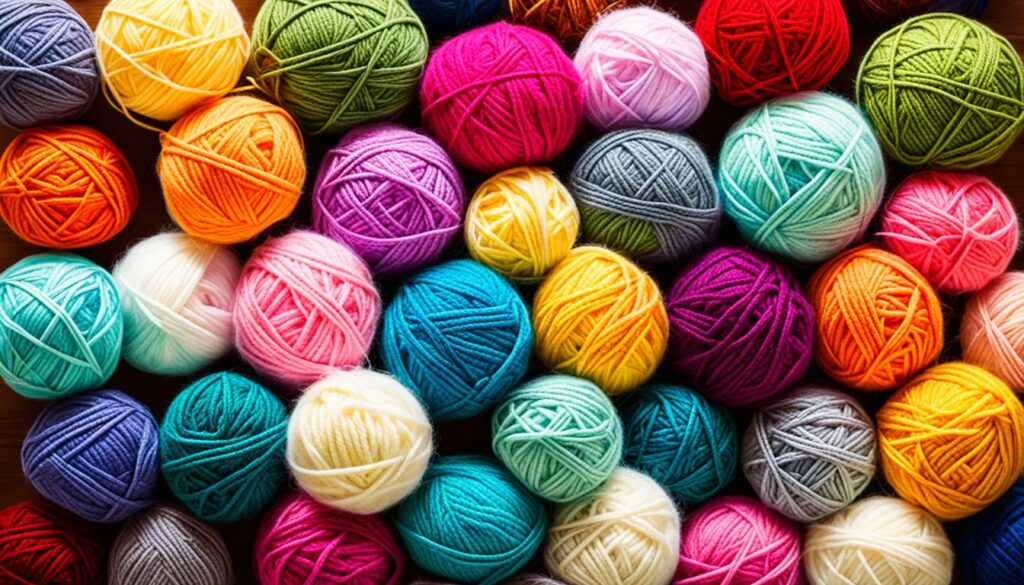
Recommended Acrylic Yarn Brands
| Brand | Properties |
|---|---|
| Red Heart | Durable, vibrant colors, affordable |
| Lion Brand | Soft, versatile, wide color range |
| Bernat | Easy to work with, excellent color retention |
Nylon Yarn
When it comes to tufting, nylon yarn is a top choice, particularly for commercial projects. Its exceptional strength, durability, and resistance to abrasion make it ideal for high-traffic areas and outdoor applications. But that’s not all – nylon yarn also offers additional benefits that make it a go-to option for many tufting enthusiasts.
Nylon yarn properties
- Stain resistance: Nylon yarn is known for its resistance to stains, which is crucial for maintaining the beauty and longevity of your tufted projects.
- Mildew and rot resistance: Thanks to its natural properties, nylon yarn is resistant to mildew and rot, making it an excellent choice for humid environments or areas prone to moisture.
- Chemical resistance: Nylon yarn is also resistant to certain chemicals, offering added durability and longevity. This makes it highly suitable for tufted projects that may come into contact with harsh cleaning agents or other chemicals.
While nylon yarn comes in various colors to suit your design preferences, it’s important to note that it may not be as easy to dye as wool or acrylic yarn. However, its many other advantages often compensate for this limitation.
“Nylon yarn’s strength, durability, and resistance to stains, mildew, rot, and chemicals make it a top choice for commercial tufting projects.”
Whether you’re working on a high-traffic area rug or an outdoor tufting project, nylon yarn can provide the strength and resilience you need. Its remarkable properties make it a reliable choice for achieving excellent results in your tufted creations.
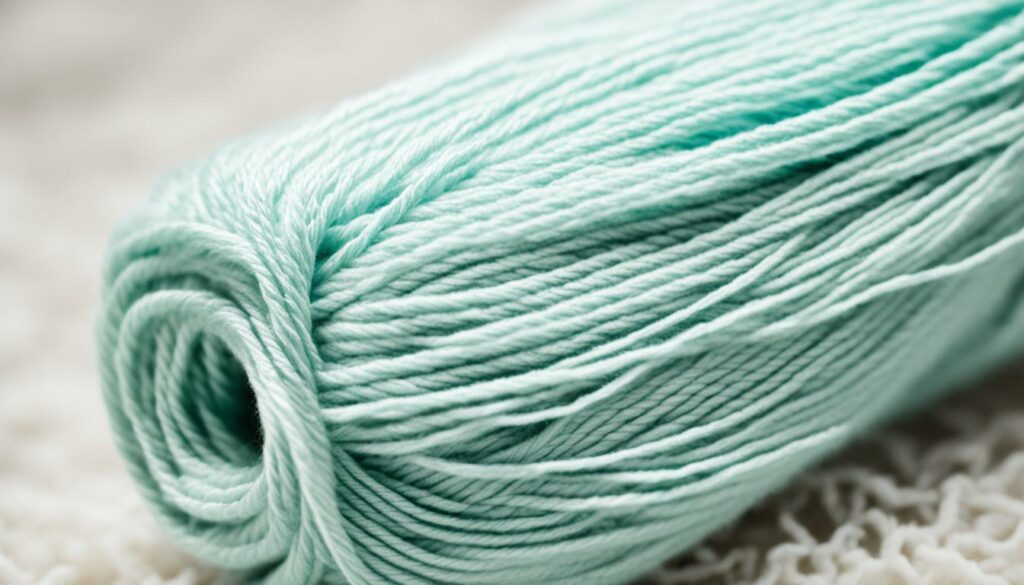
Polyester Yarn
Polyester yarn is a versatile and practical choice for tufting projects. Known for its durability and affordability, polyester yarn is designed to withstand high-traffic areas, making it an excellent option for rugs, upholstery, and other home decor items.
One of the key properties of polyester yarn is its resistance to stains, mildew, and most chemicals. This makes it an ideal choice for households with children or pets, as it can withstand spills and accidents without compromising its appearance or integrity.
In addition to its durability, polyester yarn offers a wide range of colors and textures to choose from. Whether you’re looking for bold, vibrant hues or subtle, earthy tones, polyester yarn has something to suit your aesthetic preferences. However, it’s worth mentioning that polyester yarn is not as easy to dye as wool or acrylic, so if custom colors are crucial to your project, you may want to consider other options.
Polyester yarn is also resistant to fading, ensuring that your tufted creations maintain their vibrant colors over time. It’s a low-maintenance choice that requires minimal care and can be easily cleaned with regular vacuuming or spot-cleaning.
Benefits of Polyester Yarn for Tufting:
- Durable and long-lasting
- Affordable
- Resistant to stains, mildew, and most chemicals
- Wide range of colors and textures
- Low-maintenance
- Fade-resistant
When working with polyester yarn, it’s essential to consider the specific requirements of your tufting project. Whether you’re creating a cozy rug or upholstering a chair, polyester yarn provides a practical and reliable option that combines durability, affordability, and a vast array of color choices.
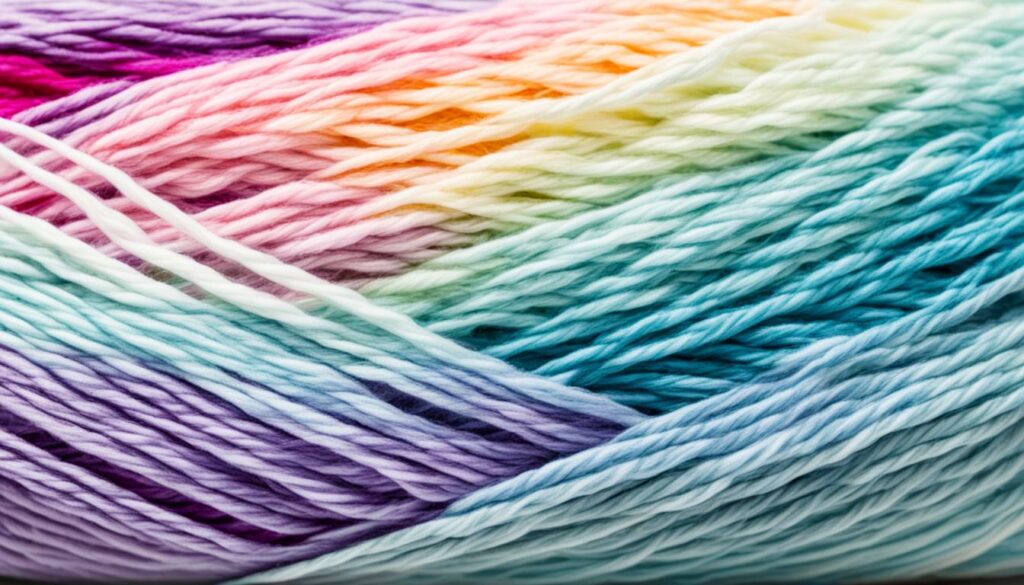
Cotton Yarn
Cotton yarn is a natural option that offers softness and absorbency, making it a popular choice for tufting projects. Its hypoallergenic properties also make it suitable for those with sensitive skin. However, it’s important to note that cotton yarn is less durable than wool or synthetic options, and it may not be as resistant to stains or mildew.
Cotton yarn is available in a variety of colors, allowing for creative and colorful tufted creations. However, it’s worth mentioning that compared to wool or acrylic, cotton yarn is not as easy to dye. This means that while you can find cotton yarn in different colors, customization options may be limited compared to other yarn types.
The Benefits of Cotton Yarn
“Cotton yarn is naturally soft and highly absorbent, making it an excellent choice for tufted projects where comfort and moisture-wicking properties are desired.”
Limited Durability and Stain Resistance
- Cotton yarn is not as durable as wool or synthetic options
- It may not be as resistant to stains and mildew
Despite its limitations, cotton yarn remains a popular choice for tufting due to its softness, absorbency, and hypoallergenic properties. Consider your specific project needs and preferences when deciding whether cotton yarn is the best option for you.
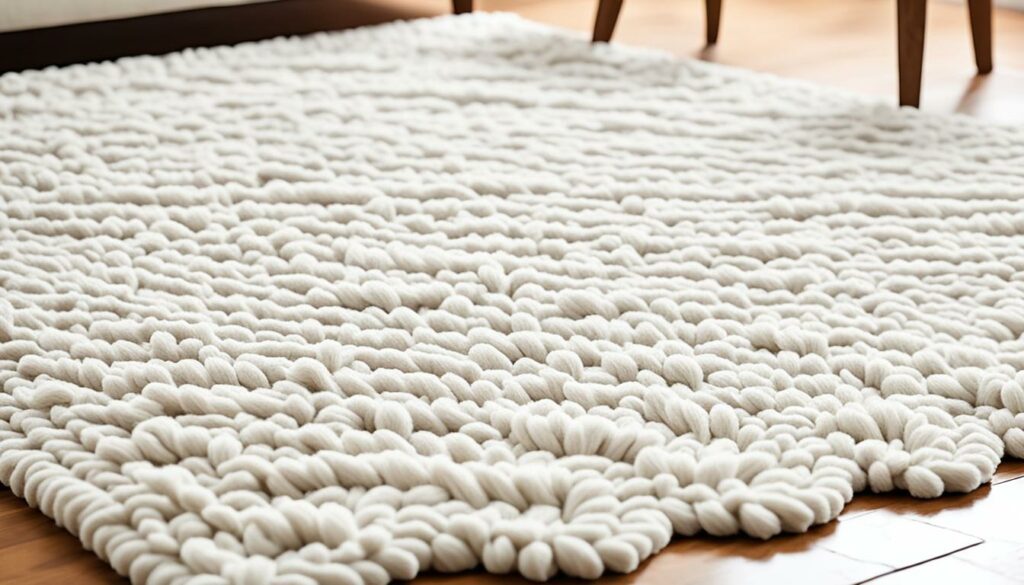
| Yarn Type | Softness | Durability | Stain Resistance | Color Options | Dyeability |
|---|---|---|---|---|---|
| Cotton Yarn | High | Low | Low | Various colors | Not as easy as wool or acrylic |
| Wool Yarn | High | High | High | Various colors | Easy |
| Acrylic Yarn | Medium | High | High | Various colors | Easy |
| Nylon Yarn | Medium | High | High | Various colors | Medium |
| Polyester Yarn | Medium | High | High | Various colors | Medium |
Blended Yarn
Blended yarn is a versatile option for tufting, offering a unique combination of properties from different fibers. Typically, blended yarn is made by mixing wool and synthetic fibers, creating a balance between softness, durability, and colorfastness.
Blended yarns provide the best of both worlds. They offer the natural softness and luxurious feel of wool, along with the strength and color options of synthetic fibers. This combination makes blended yarn a popular choice for tufting projects.
With blended yarns, you can achieve the desired texture and appearance while ensuring the durability needed for long-lasting tufted creations. The different fibers work together harmoniously to create a yarn that is suitable for a variety of applications.
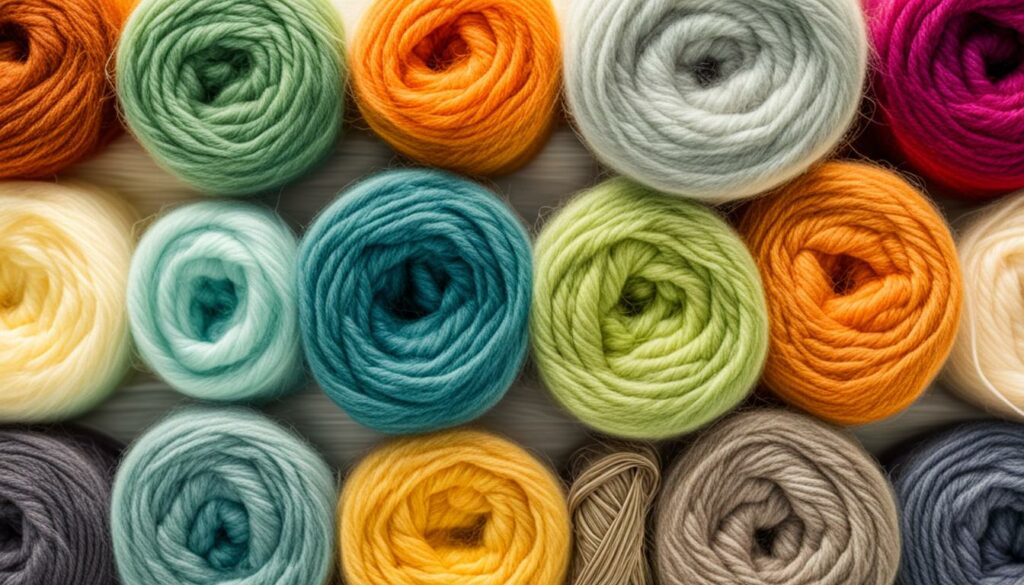
Blended yarns come in a wide range of colors and textures, allowing for creative freedom and customization. Whether you want a cozy and plush rug or a more modern and textured design, blended yarns can help you bring your vision to life.
When selecting a blended yarn for your tufting project, consider the specific blend of fibers and their properties. Each blend may have different characteristics, so choose one that aligns with your desired outcome.
Experimenting with blended yarns can lead to exciting results and unique tufted creations. Let your creativity flow and explore the possibilities that this versatile yarn option has to offer.
Choosing the Right Yarn for Your Tufting Project
Selecting the right yarn for your tufting project plays a crucial role in achieving the desired texture, durability, and appearance. Each yarn type brings unique properties to the table, allowing you to create a tufted masterpiece perfectly tailored to your needs. Let’s explore the factors to consider when choosing yarn for tufting and how to make the selection process a rewarding experience.
1. Texture and Feel
When choosing yarn for tufting, consider the texture and feel that will complement your project. Some yarns, like wool, offer a soft and luxurious texture, creating a cozy and plush look. For a more modern aesthetic, acrylic yarn provides an even and smooth texture. Synthetic yarns, such as nylon or polyester, offer durability and a sleek appearance. Cotton yarn, on the other hand, provides a natural and breathable feel. Think about the overall look and feel you want to achieve and choose a yarn that aligns with your vision.
2. Durability and Strength
Determining the durability and strength of the yarn is essential for long-lasting tufting projects. Wool yarn is known for its natural resilience and ability to withstand heavy use. Synthetic yarns like acrylic, nylon, and polyester offer superior strength, making them ideal for high-traffic areas. Cotton yarn, while soft, might be less durable than its synthetic counterparts. Consider the level of foot traffic or wear and tear that your tufted piece will experience and choose a yarn that can withstand the demands of your environment.
3. Color Options and Dyeability
Color plays a significant role in the visual impact of your tufting project. Some yarns, like wool and acrylic, offer a wide range of pre-dyed colors to choose from, making it easier to find the perfect shade for your design. These yarns can also be custom dyed to achieve specific color combinations. However, nylon and polyester yarns may be more challenging to dye due to their synthetic properties. If you have a specific color palette in mind, consider the dyeability of the yarn options available to ensure you can achieve the desired hues.
4. Allergies and Sensitivities
For individuals with allergies or sensitivities, it’s crucial to choose a yarn that won’t trigger any adverse reactions. Wool yarn is naturally hypoallergenic and resistant to mold, mildew, and dust mites. Acrylic, nylon, and polyester yarns, being synthetic fibers, are less likely to cause allergies. Cotton yarn is another hypoallergenic option for those with sensitivities. Consider your personal needs when selecting yarn and opt for a yarn that won’t compromise your comfort or health.
5. Experimental Freedom
Don’t be afraid to think outside the box and experiment with different yarn types. The beauty of tufting lies in its versatility and the endless creative possibilities it offers. Mix and match yarns to create unique textures and visual effects. Blend natural fibers with synthetic materials to combine the best of both worlds. With a fearless approach to yarn selection, you can uncover new and exciting results that truly showcase your artistic vision.
Remember, choosing the right yarn for your tufting project is an opportunity to infuse your personal style and creativity into every tufted stitch. Consider the texture, durability, color options, and your own personal needs when making your selection. Don’t be afraid to step outside your comfort zone and explore different yarn types to achieve stunning tufted creations that leave a lasting impression.
Now that we’ve covered the essentials of selecting the perfect yarn for your tufting project, let’s move on to another key tool in the tufting process: tufting guns.
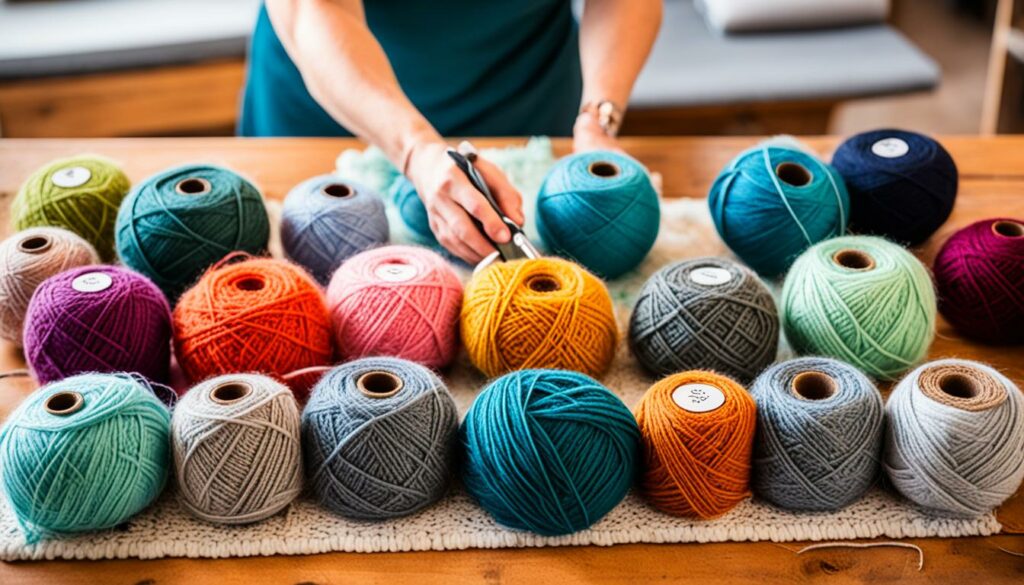
Tufting Guns: A Key Tool for Tufting
Tufting guns play a crucial role in achieving professional-looking tufted rugs and crafts. These specialized tools help simplify the tufting process and allow for precise and intricate designs. Whether you’re a beginner or an experienced tufter, understanding the different types of tufting guns can help you choose the right one for your project.
Loop Pile Tufting Guns
Loop pile tufting guns are ideal for creating plush, luxurious rugs with a raised loop texture. The loops formed by these guns remain uncut, creating a softer and more textured surface. Loop pile tufting guns are popular for traditional and classic rug designs, as well as for adding depth and dimension to modern patterns.
Cut Pile Tufting Guns
Cut pile tufting guns are perfect for achieving a modern and sleek look. Unlike loop pile guns, these guns create cut pile rugs by slicing the loops formed during the tufting process. This results in a dense and even surface with a plush feel. Cut pile tufting guns offer precise control and are well-suited for creating intricate designs and patterns.
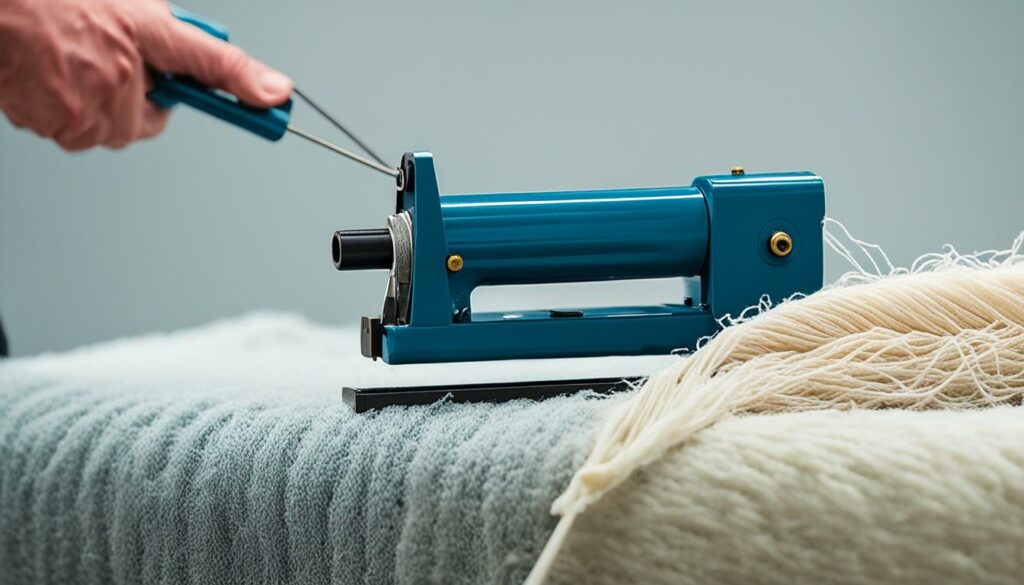
Choosing the Right Tufting Gun
When selecting a tufting gun, consider the style and texture you want to achieve in your project. If you prefer a softer and more textured finish, a loop pile tufting gun would be the better choice. On the other hand, if you’re aiming for a modern and sleek appearance, a cut pile tufting gun will help you achieve that look.
Beginners may find cut pile tufting guns easier to use due to their simpler technique and more forgiving results. However, with practice and experimentation, tufters of all skill levels can master the art of tufting with both types of guns.
In conclusion, tufting guns are indispensable tools for tufting enthusiasts and professionals alike. The choice between loop pile and cut pile guns depends on the desired texture and style of your project. By selecting the right tufting gun and exploring different techniques, you can bring your tufted creations to life.
Frames for Tufting: Holding Everything in Place
Tufting frames are an essential tool for keeping your fabric secure and taut during the tufting process. Whether you’re working on a small rug or a larger project, choosing the right frame size is crucial. By using the appropriate tufting frame, you’ll achieve better tension and accuracy in your tufting stitches.
To accommodate different project sizes, tufting frames come in various sizes. You can select a frame that fits the dimensions of your rug perfectly, ensuring a smooth and consistent tension across the fabric. This helps to prevent any loose or uneven areas in your tufted design.
It’s important to tightly secure the fabric to the frame to maintain stability throughout the tufting process. You can use carpet tack strips or a staple gun to keep the fabric in place. Make sure to distribute the tension evenly and avoid any excess sagging or pulling.
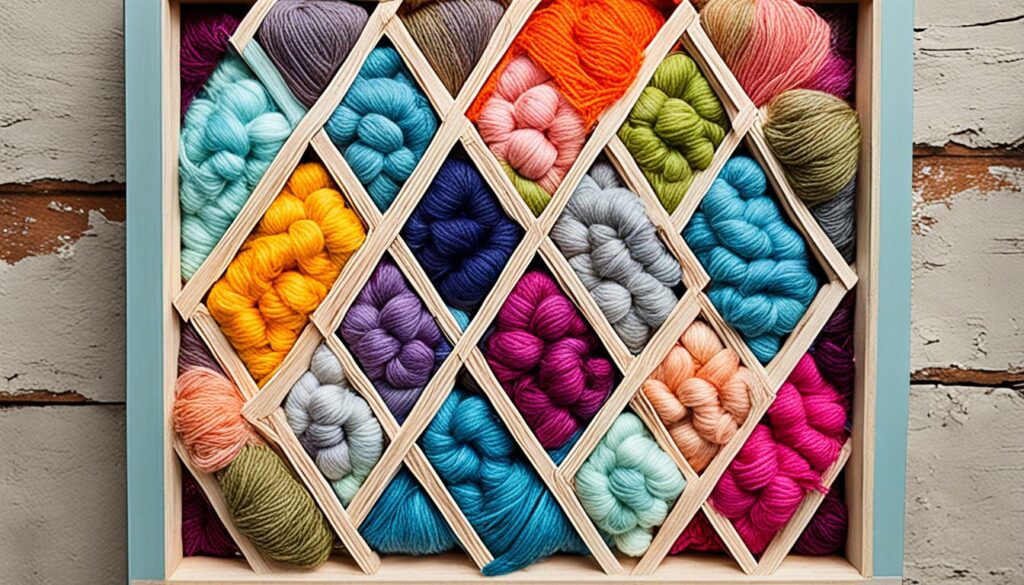
Choosing the Right Size Frame
When selecting a tufting frame, consider the dimensions of your project. If you’re working on a smaller rug or a crafts project, a smaller frame will be sufficient. However, larger rugs or tapestries will require a larger frame to provide the necessary workspace.
Pro Tip: Measure your fabric and add a few inches to the dimensions to ensure that it fits on the frame comfortably without any stretching.
Remember, the frame should be sturdy and rigid to support the tension of the fabric. Look for frames made from hardwood or metal for durability and stability.
Securing the Fabric
Before attaching the fabric to the frame, make sure to prepare it properly. Iron out any wrinkles or creases in the fabric to achieve a smooth surface. Align the fabric on the frame, ensuring that it’s centered and straight.
Using carpet tack strips or a staple gun, start securing the fabric to the frame. Begin at one edge and work your way around, pulling the fabric tightly as you go. Make sure to distribute the tension evenly across all sides to avoid any distortion in the tufted design.
The fabric should be smooth and taut across the frame, without any loose or sagging areas. Double-check for any wrinkles or folds and adjust as necessary before starting your tufting project.
Materials for Tufting: Which Fabric to Use
When it comes to tufting, choosing the right fabric is crucial for achieving successful results. Two commonly used options are monks cloth and primary tufting material. Let’s take a closer look at each of these fabric choices:
Monks Cloth
Monks cloth is a durable and versatile fabric that is commonly used for tufting projects. It is known for its ease of use and ability to withstand the tufting process. Monks cloth comes in various colors, allowing you to add a pop of personality to your tufted creations. Whether you’re a beginner or an experienced tufter, monks cloth is a reliable choice.
Primary Tufting Material
Primary tufting material is a blend of cotton and polyester fibers. This fabric is elastic, making it easy to stretch and secure onto the tufting frame. The combination of cotton and polyester creates a durable and resilient material that is suitable for a variety of tufting projects. With primary tufting material, you can achieve a professional-looking finish with ease.
When selecting the fabric for your tufting project, consider factors such as durability, ease of use, and color options. Both monks cloth and primary tufting material offer unique benefits that make them ideal choices for tufting. Experiment with different fabrics to discover the one that best suits your needs and preferences.
Conclusion
Choosing the best yarn for tufting is a personal decision that depends on your project’s requirements and your own preferences. Consider the properties of each yarn type, such as durability, softness, and color options, to find the perfect match for your tufted creations. Remember, tufting is all about creativity and experimentation, so don’t be afraid to try different yarns to achieve unique and stunning results.
We hope this tufting yarn guide has provided you with valuable insights and recommendations to help you in your tufting journey. Whether you prefer the natural softness of wool, the affordability and color options of acrylic, the strength and durability of nylon, the versatility of polyester, or the comfort of cotton, there is a yarn out there that will suit your needs.
So go ahead, explore the world of tufting yarns, unleash your imagination, and create beautiful tufted masterpieces that will leave a lasting impression. Happy tufting!
